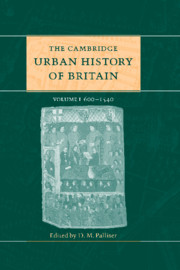Book contents
- Frontmatter
- Part I Introductory
- Part II The early middle ages 600–1300
- 3 General survey 600–1300
- 4 Power and authority 600–1300
- 5 Society and population 600–1300
- 6 The economy of British towns 600–1300
- 7 Churches, education and literacy in towns 600–1300
- 8 The topography of towns 600–1300
- 9 London from the post-Roman period to 1300
- 10 The large towns 600–1300
- 11 Small towns 600–1270
- Part III The later middle ages 1300–1540
- Part IV Regional surveys
- Part V Conclusion
- Appendix: Ranking lists of English medieval towns
- Select bibliography
- Index
- References
6 - The economy of British towns 600–1300
from Part II - The early middle ages 600–1300
Published online by Cambridge University Press: 28 March 2008
- Frontmatter
- Part I Introductory
- Part II The early middle ages 600–1300
- 3 General survey 600–1300
- 4 Power and authority 600–1300
- 5 Society and population 600–1300
- 6 The economy of British towns 600–1300
- 7 Churches, education and literacy in towns 600–1300
- 8 The topography of towns 600–1300
- 9 London from the post-Roman period to 1300
- 10 The large towns 600–1300
- 11 Small towns 600–1270
- Part III The later middle ages 1300–1540
- Part IV Regional surveys
- Part V Conclusion
- Appendix: Ranking lists of English medieval towns
- Select bibliography
- Index
- References
Summary
demand for urban goods and services
No definition of the word town is very convenient for the analysis of medieval economies. It is tempting to take the contemporary term burh or burgus as a proxy, but this needs resisting because there was so little consistency or stability in the way the word was used. Population levels might serve as a guide if they were reliably known for each town, but they are not. Differences of taxable wealth are on record, and for 1334 can be charted for most of England, but they depend upon the size of the assessed area and the social distribution of wealth to such an extent that there is considerable overlap between places with ‘urban’ features (craftsmen, traders, marketing institutions) and places dependent solely on rural pursuits. It will be assumed here, first, that a necessary condition for being considered a town is that a settlement should have some institutional apparatus for regular local or long-distance trade; from the eleventh century onwards this would normally mean at least a weekly market. Secondly, a settlement with this institutional provision is classifiable as a town if its income depends to a perceptible degree upon the sale of manufactures and services to buyers external to the body of townsmen. Buyers external to the urban community, in this context, may mean large households or bodies of administrative personnel adjacent to the town; describing such purchasers as external is justifiable because large households of all kinds normally drew most of their income from outside the town in which they were placed.
- Type
- Chapter
- Information
- The Cambridge Urban History of Britain , pp. 105 - 126Publisher: Cambridge University PressPrint publication year: 2000
References
- 3
- Cited by



